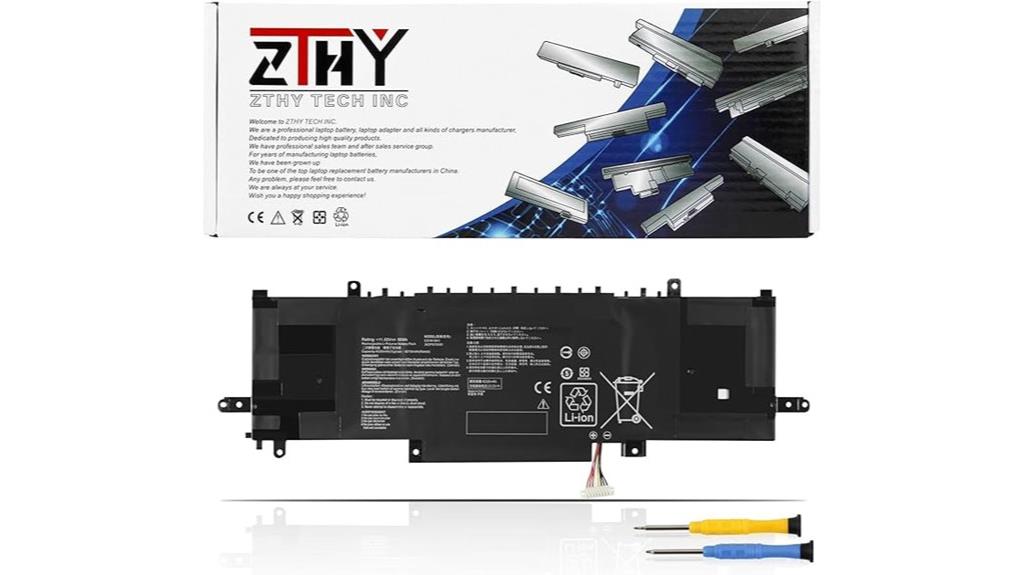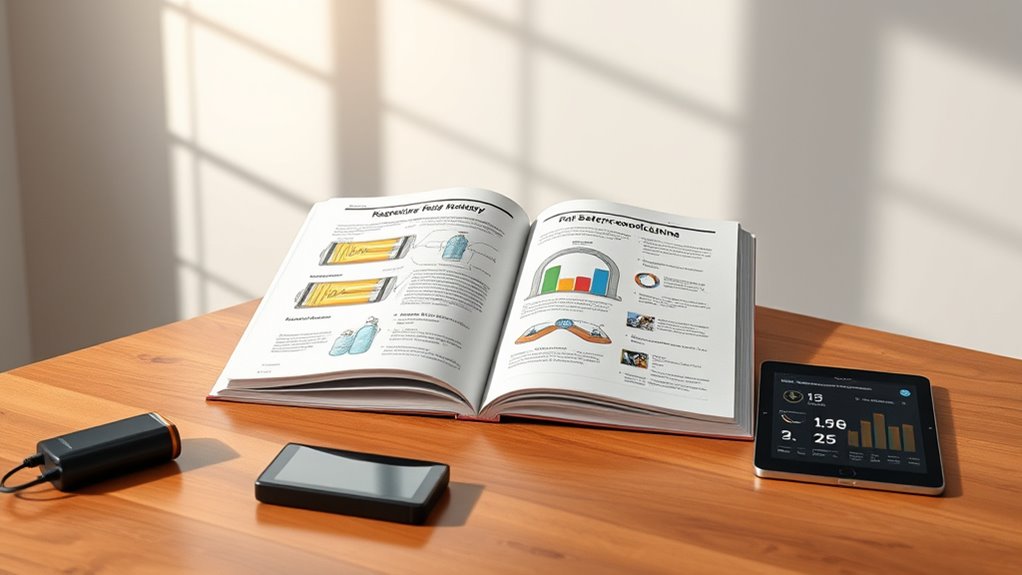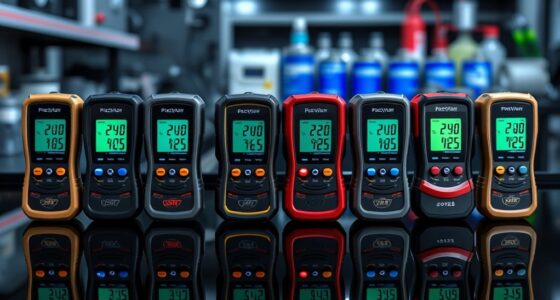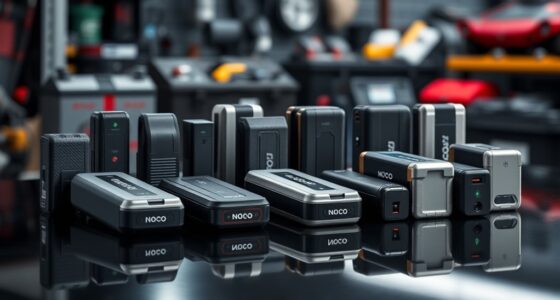If you’re looking to save money and extend your batteries’ lifespan, I recommend two top e-books for 2025. One covers deep cycling and desulfation techniques tailored for various battery types, emphasizing safety and compatibility. The other focuses on cost-effective reconditioning methods with clear material lists and skill level guidance. Both guides are credible, backed by scientific info, and include safety tips. Keep going to discover more ways these resources can help you master battery care and reconditioning.
Key Takeaways
- Look for e-books with comprehensive deep cycling and desulfation techniques compatible with various battery types like lithium-ion and lead-acid.
- Prioritize guides that emphasize safety protocols, including proper handling, safety gear, and manufacturer instructions.
- Choose books offering clear, step-by-step instructions suitable for your skill level, from beginners to advanced repair techniques.
- Ensure the e-books are credible, with certifications, author expertise, positive reviews, and scientific backing.
- Select guides that include detailed material lists, troubleshooting tips, and cost-effective methods to maximize savings and success.
GHU New Battery Replacement for HP Elitebook 6930P 6730B 6530B 6450B 6540B 6550B 6555B 6440B

Are you looking for a reliable replacement battery for your HP Elitebook 6930P or similar models? The GHU New Battery Replacement offers a 58Wh capacity, compatible with many HP models like the 6730B, 6530B, 6450B, and others. It fits perfectly, ensuring reliable power and longevity. Designed for over 500 recharge cycles, this lithium-ion battery supports fast charging and delivers lasting performance. Certified for safety and quality, it arrives well-packaged and easy to install. While some initial hiccups like short runtimes can occur, customer support helps resolve issues quickly. It’s a cost-effective, dependable choice for extending your laptop’s lifespan.
Best For: users seeking a reliable, cost-effective replacement battery for HP Elitebook and Probook models to extend their laptop’s lifespan and ensure consistent performance.
Pros:
- Compatible with a wide range of HP Elitebook and Probook models, ensuring versatile use
- Supports over 500 recharge cycles for long-term durability and value
- Certified for safety and quality, with fast charging capabilities and easy installation
Cons:
- Initial charge levels may be low, requiring calibration or replacement if issues arise
- Performance can vary depending on usage conditions and calibration accuracy
- As an aftermarket product, battery life may be inconsistent compared to OEM options
ZTHY C31N1841 Battery Replacement for Asus ZenBook Series

If you’re looking to restore your Asus ZenBook’s battery performance, the ZTHY C31N1841 replacement offers a reliable option for tech-savvy users willing to follow proper installation and cycling procedures. This Li-Polymer battery is compatible with various ZenBook models, including UX334, UX434, and UX463 series. It’s CE and UL certified, ensuring safety and quality. To activate it properly, discharge to 10-20%, then recharge and cycle 3-4 times. Weighing just over 10 ounces, it’s easy to install. Keep in mind, some users report early failures or rapid drain, so warranty support is essential. Proper handling can extend its lifespan effectively.
Best For: tech-savvy users seeking a compatible replacement battery to restore their Asus ZenBook’s performance and extend its usage time.
Pros:
- CE and UL certified for safety and environmental compliance
- Compatible with a wide range of ZenBook models including UX334, UX434, and UX463 series
- Lightweight design weighing just over 10 ounces for easy installation
Cons:
- Some users report rapid battery drain within approximately 30 days
- Occasional issues with the battery not being recognized initially after installation
- Reports of early failure or defectiveness, including no charge or unexpected shutdowns
Factors to Consider When Choosing a Battery Reconditioning E‑Book

When choosing a battery reconditioning e-book, I look closely at the techniques it covers to guarantee they’re effective and easy to follow. I also check for compatibility info, safety tips, and whether the materials required are affordable and accessible. Considering these factors helps me pick a guide that’s safe, practical, and budget-friendly.
Reconditioning Techniques
Choosing the right battery reconditioning e-book means paying close attention to the techniques it covers, as these directly impact the effectiveness and safety of your efforts. Look for guides that detail deep cycling methods to restore capacity and extend battery life. Proper desulfation techniques are essential for lead-acid batteries, eliminating sulfate buildup to improve performance. A good e-book should explain using specialized chargers and equalization processes to balance cell voltage and prevent overcharging. It’s also important that it covers chemical cleaning and physical inspections to identify corrosion or damage. Finally, the best resources emphasize consistent testing and calibration, ensuring your reconditioned batteries meet safety and performance standards. Clear, step-by-step instructions are key to mastering these techniques safely and effectively.
Compatibility Information
Selecting the right battery reconditioning e-book requires ensuring it covers the specific battery type you’re working with, such as lithium-ion or lithium-polymer. I always check if the guide includes instructions compatible with my battery’s voltage, capacity, and size to avoid damage. It’s also important that the e-book addresses the particular device or model I’m working on, like my laptop or smartphone. I look for compatibility details that show how the techniques apply across different brands and part numbers. Additionally, I verify if the guide offers troubleshooting tips tailored to my battery type and device, helping me diagnose issues accurately. Ensuring these compatibility factors are covered saves me time and prevents costly mistakes during reconditioning.
Safety Precautions
Ensuring safety is essential when reconditioning batteries, so I always look for e-books that emphasize proper precautions. The best guides stress disconnecting batteries from power sources and turning off devices to prevent electrical shocks. They recommend using insulated tools and wearing safety gloves to avoid short circuits, chemical exposure, or shocks during the process. Following manufacturer instructions and safety data sheets is crucial to minimize fire risks and chemical leaks. Working in a well-ventilated area helps disperse harmful fumes or gases that may be released. Additionally, inspecting batteries for damage—such as swelling, corrosion, or leaks—is vital; reconditioning should never be attempted on compromised batteries. These safety measures protect you and ensure a smooth, hazard-free process.
Cost Effectiveness
A well-chosen battery reconditioning extensive-style e-book can save you a significant amount of money over time by teaching you how to extend the life of your rechargeable batteries. The initial cost of an e-book is usually much lower than buying new batteries or paying for professional services. By learning proper reconditioning techniques, I can reduce the frequency of replacements and get more value from each battery. This long-term savings makes investing in a comprehensive guide worthwhile, especially for high-use devices. With detailed, step-by-step instructions, I can recondition multiple batteries myself, further cutting costs. Overall, a good e-book offers a cost-effective solution that helps me save money while maintaining reliable power sources for my gadgets.
Material Requirements
When choosing a battery reconditioning e-book, it’s vital to look for detailed descriptions of the tools, chemicals, and replacement parts you’ll need. A good guide should specify which batteries are compatible, such as lithium-ion, NiMH, or lead-acid, to guarantee you’re using the correct methods. Clear illustrations or diagrams of materials and equipment help prevent mistakes during reconditioning. Safety gear like gloves and eye protection should be emphasized, given the hazardous chemicals involved. The e-book should also stress sourcing high-quality, compatible materials to improve success rates and avoid damaging batteries. Having precise, well-explained material requirements ensures you’re prepared, minimizes risks, and maximizes the effectiveness of your reconditioning efforts.
Skill Level Needed
Choosing the right battery reconditioning e-book depends heavily on your skill level and technical background. If you’re a beginner, look for guides with straightforward, step-by-step instructions and clear diagrams, which make complex processes more accessible. Some e-books require only basic electrical knowledge, like understanding voltage and current, while others explore into advanced techniques such as circuit repair or soldering. If you lack experience in these areas, starting with simpler methods is wise to avoid frustration or damage. Evaluating the skill level needed helps you decide if additional practice or training is necessary beforehand. Selecting an e-book aligned with your current abilities ensures a smoother learning curve and a more successful reconditioning process, saving time and reducing risks.
Time Investment
Since reconditioning a battery involves multiple steps like discharging, cleaning, and recharging, it can take anywhere from a few hours to several days depending on the battery type, so it’s important to contemplate how much time you’re willing to invest. Some batteries can be reconditioned in just a few hours, while others require multiple days for complete restoration. Consistent monitoring during the process is crucial, which adds to the overall time. Reading and understanding the e-book thoroughly can help streamline the process, reducing trial and error. If you’re willing to dedicate enough time upfront, you’ll likely achieve better results and extend your batteries’ lifespan. Choosing an e-book that clarifies the time commitments involved helps you set realistic expectations and plan accordingly.
Certification & Credibility
Ever wondered how to tell if a battery reconditioning e-book is trustworthy? Certification from reputable organizations like UL or CE shows the book meets recognized safety and quality standards, giving you peace of mind. Credibility is also built through the author’s qualifications, their industry experience, and positive reviews from other users. Verified certifications boost trust in the methods presented, ensuring they follow safety guidelines for handling and reconditioning batteries. An authoritative e-book cites scientific research, manufacturer instructions, or industry best practices, making its techniques more reliable. Ultimately, certifications and credible credentials help you distinguish between trustworthy guides and those that may offer unsafe or ineffective methods. Choosing an e-book with proper certification and proven credibility is key to safe, effective battery reconditioning.
Frequently Asked Questions
Are There Any Legal Restrictions on Battery Reconditioning?
Yes, there are legal restrictions on battery reconditioning, depending on where you live. I always recommend checking local laws because some areas regulate or restrict the process, especially for certain types of batteries like car or industrial ones. I make sure to follow safety guidelines and dispose of batteries responsibly. Being informed helps me avoid legal issues and ensures I recondition batteries safely and lawfully.
Can These E-Books Teach Safety Precautions Effectively?
They say safety first, and these e-books definitely teach it well. I’ve found that clear instructions, step-by-step guides, and highlighted warnings make all the difference. They use simple language and visuals to help you understand potential hazards. I believe anyone can learn safe reconditioning practices if they pay attention and follow the advice carefully. So, yes, these e-books are effective in teaching safety precautions to keep you protected.
Do the E-Books Cover Lithium-Ion and Lead-Acid Batteries?
Yes, these e-books cover lithium-ion and lead-acid batteries thoroughly. I’ve found them to be incredibly informative, explaining the specific reconditioning techniques for each type. They break down complex processes into easy-to-understand steps, which helps me feel confident when working on different batteries. If you’re interested in expanding your knowledge on reconditioning various battery types, these books are a valuable resource to have on hand.
Are There Recommended Tools Included in These Guides?
Did you know that over 70% of battery reconditioning success depends on having the right tools? I’ve found that many top guides include recommended tools like multimeters, specialized chargers, and safety gear. These tools are essential for testing, repairing, and safely reconditioning batteries. When you follow the guides, having these tools on hand makes the process smoother and more effective, saving you time and effort.
How Often Should Battery Reconditioning Be Performed?
I usually recondition my batteries every six months to keep them in ideal condition. However, the frequency depends on usage and battery type. If I notice my device isn’t holding a charge like it used to, I’ll recondition sooner. Regular reconditioning helps extend battery life, saves money, and improves performance. I recommend keeping an eye on your batteries and reconditioning as needed to maintain their efficiency over time.
Conclusion
Choosing the right battery reconditioning e-book isn’t just about techniques; it’s about understanding your skill level and time commitment. While some guides promise quick fixes, true mastery requires patience and credibility. As I’ve learned, the best resources balance detailed methods with realistic expectations. In the end, investing in the right knowledge transforms frustration into confidence, turning complex science into achievable results—because reconditioning batteries isn’t just a skill, it’s a sustainable way to save money and the environment.










